Seven Wonders Of The World
Various lists of the Wonders of the World have been compiled from antiquity to the present day, to catalogue the world’s most spectacular natural wonders and manmade structures.
The Seven Wonders of the Ancient World is the first known list of the most remarkable creations of classical antiquity; it was based on guidebooks popular among Hellenic sightseers and only includes works located around the Mediterranean rim and in Mesopotamia. The number seven was chosen because the Greeks believed it represented perfection and plenty, and because it was the number of the five planets known anciently, plus the sun and moon.
1. Colossus of Rhodes
The Colossus of Rhodes (Ancient Greek: ὁ Κολοσσὸς Ῥόδιος) was a statue of the Greek sun-god Helios, erected in the city of Rhodes, on the Greek island of the same name, by Chares of Lindos in 280 BC. One of the Seven Wonders of the Ancient World, it was constructed to celebrate Rhodes’ victory over the ruler of Cyprus, Antigonus I Monophthalmus, whose son Demetrius I of Macedon unsuccessfully besieged Rhodes in 305 BC. According to most contemporary descriptions, the Colossus stood approximately 70 cubits, or 33 metres (108 feet) high—the approximate height of the modern Statue of Liberty from feet to crown—making it the tallest statue of the ancient world. It collapsed during the earthquake of 226 BC; although parts of it were preserved, it was never rebuilt.
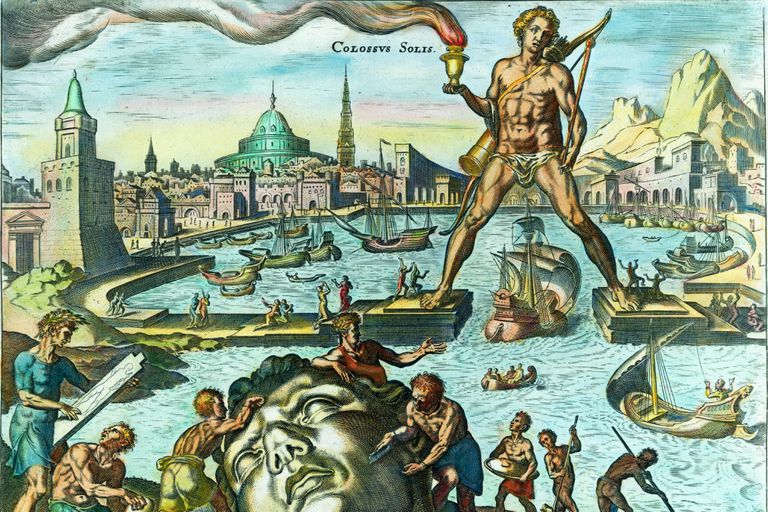
As of 2015, there are tentative plans to build a new Colossus at Rhodes Harbour, although the actual location of the original remains in dispute.
Construction began in 292 BC. Ancient accounts, which differ to some degree, describe the structure as being built with iron tie bars to which brass plates were fixed to form the skin. The interior of the structure, which stood on a 15-metre-high (49-foot) white marble pedestal near the Mandraki harbour entrance, was then filled with stone blocks as construction progressed. Other sources place the Colossus on a breakwater in the harbour. According to most contemporary descriptions, the statue itself was about 70 cubits, or 33 metres (108 feet) tall. Much of the iron and bronze was reforged from the various weapons Demetrius’s army left behind, and the abandoned second siege tower may have been used for scaffolding around the lower levels during construction. Upper portions were built with the use of a large earthen ramp. During the building, workers would pile mounds of earth on the sides of the colossus. Upon completion all of the earth was removed and the colossus was left to stand alone. After twelve years, in 280 BC, the statue was completed. Preserved in Greek anthologies of poetry is what is believed to be the genuine dedication text for the Colossus.
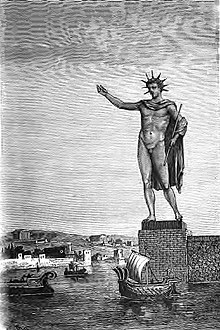
To you, O Sun, the people of Dorian Rhodes set up this bronze statue reaching to Olympus, when they had pacified the waves of war and crowned their city with the spoils taken from the enemy. Not only over the seas but also on land did they kindle the lovely torch of freedom and independence. For to the descendants of Herakles belongs dominion over sea and land.
Modern engineers have put forward a plausible hypothesis for the statue’s construction, based on the technology of the time (which was not based on the modern principles of earthquake engineering), and the accounts of Philo and Pliny, who saw and described the ruins.
The base pedestal was said to be at least 18 metres (59 feet) in diameter, and either circular or octagonal. The feet were carved in stone and covered with thin bronze plates riveted together. Eight forged iron bars set in a radiating horizontal position formed the ankles and turned up to follow the lines of the legs while becoming progressively smaller. Individually cast curved bronze plates 60 inches (1,500 mm) square with turned-in edges were joined together by rivets through holes formed during casting to form a series of rings. The lower plates were one inch (25 mm) in thickness to the knee and 3⁄4-inch (20 mm) thick from knee to abdomen, while the upper plates were 1⁄4–1⁄2-inch (6.5–12.5 mm) thick except where additional strength was required at joints such as the shoulder, neck, etc.
2. Great Pyramid of Giza
The Great Pyramid of Giza (also known as the Pyramid of Khufu or the Pyramid of Cheops) is the oldest and largest of the three pyramids in the Giza pyramid complex bordering what is now El Giza, Egypt. It is the oldest of the Seven Wonders of the Ancient World, and the only one to remain largely intact.
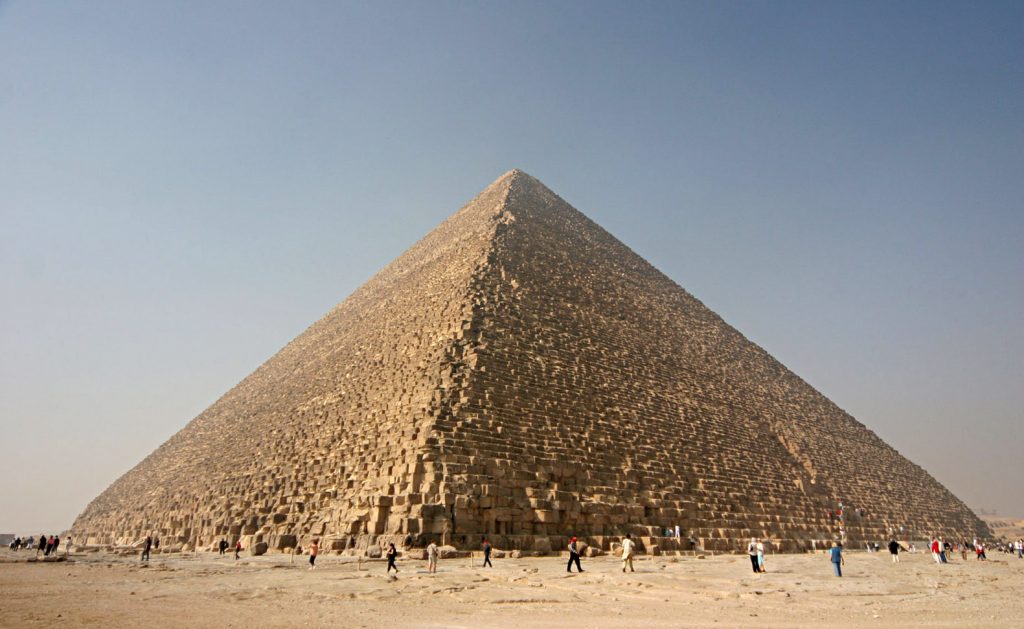
Based on a mark in an interior chamber naming the work gang and a reference to the fourth dynasty Egyptian Pharaoh Khufu, Egyptologists believe that the pyramid was built as a tomb over a 10- to 20-year period concluding around 2560 BC. Initially at 146.5 metres (481 feet), the Great Pyramid was the tallest man-made structure in the world for more than 3,800 years. Originally, the Great Pyramid was covered by limestone casing stones that formed a smooth outer surface; what is seen today is the underlying core structure. Some of the casing stones that once covered the structure can still be seen around the base. There have been varying scientific and alternative theories about the Great Pyramid’s construction techniques. Most accepted construction hypotheses are based on the idea that it was built by moving huge stones from a quarry and dragging and lifting them into place.
There are three known chambers inside the Great Pyramid. The lowest chamber is cut into the bedrock upon which the pyramid was built and was unfinished. The so-called Queen’s Chamber and King’s Chamber are higher up within the pyramid structure. The main part of the Giza complex is a set of buildings that included two mortuary temples in honour of Khufu (one close to the pyramid and one near the Nile), three smaller pyramids for Khufu’s wives, an even smaller “satellite” pyramid, a raised causeway connecting the two temples, and small mastaba tombs surrounding the pyramid for nobles.
Many alternative, often contradictory, theories have been proposed regarding the pyramid’s construction techniques. Many disagree on whether the blocks were dragged, lifted, or even rolled into place. The Greeks believed that slave labour was used, but modern discoveries made at nearby workers’ camps associated with construction at Giza suggest that it was built instead by tens of thousands of skilled workers. Verner posited that the labour was organized into a hierarchy, consisting of two gangs of 100,000 men, divided into five zaa or phyle of 20,000 men each, which may have been further divided according to the skills of the workers.
One mystery of the pyramid’s construction is its planning. John Romer suggests that they used the same method that had been used for earlier and later constructions, laying out parts of the plan on the ground at a 1-to-1 scale. He writes that “such a working diagram would also serve to generate the architecture of the pyramid with precision unmatched by any other means”. He also argues for a 14-year time-span for its construction. A modern construction management study, in association with Mark Lehner and other Egyptologists, estimated that the total project required an average workforce of about 14,500 people and a peak workforce of roughly 40,000. Without the use of pulleys, wheels, or iron tools, they used critical path analysis methods, which suggest that the Great Pyramid was completed from start to finish in approximately 10 years.
3. Hanging Gardens of Babylon
The Hanging Gardens of Babylon were one of the Seven Wonders of the Ancient World as listed by Hellenic culture, described as a remarkable feat of engineering with an ascending series of tiered gardens containing a wide variety of trees, shrubs, and vines, resembling a large green mountain constructed of mud bricks, and said to have been built in the ancient city of Babylon, near present-day Hillah, Babil province, in Iraq. Its name is derived from the Greek word kremastós (κρεμαστός, lit. “overhanging”), which has a broader meaning than the modern English word “hanging” and refers to trees being planted on a raised structure such as a terrace.
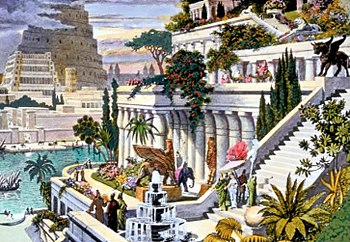
According to one legend, the Hanging Gardens were built alongside a grand palace known as The Marvel of Mankind, by the Neo-Babylonian King Nebuchadnezzar II (who ruled between 605 and 562 BC), for his Median wife Queen Amytis, because she missed the green hills and valleys of her homeland. This was attested to by the Babylonian priest Berossus, writing in about 290 BC, a description that was later quoted by Josephus. The construction of the Hanging Gardens has also been attributed to the legendary queen Semiramis, who supposedly ruled Babylon in the 9th century BC, and they have been called the Hanging Gardens of Semiramis as an alternate name.
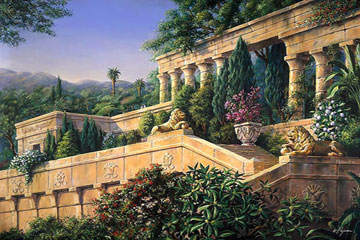
The Hanging Gardens are the only one of the Seven Wonders for which the location has not been definitively established. There are no extant Babylonian texts that mention the gardens, and no definitive archaeological evidence has been found in Babylon. Three theories have been suggested to account for this. One: that they were purely mythical, and the descriptions found in ancient Greek and Roman writers including Strabo, Diodorus Siculus and Quintus Curtius Rufus represent a romantic ideal of an eastern garden. Two: that they existed in Babylon, but were completely destroyed sometime around the first century AD. Three: that the legend refers to a well-documented garden that the Assyrian King Sennacherib (704–681 BC) built in his capital city of Nineveh on the River Tigris, near the modern city of Mosul.
4. Lighthouse of Alexandria
The Lighthouse of Alexandria, sometimes called the Pharos of Alexandria (/ˈfɛərɒs/; Ancient Greek: ὁ Φάρος τῆς Ἀλεξανδρείας, contemporary Koine Greek pronunciation: [ho pʰá.ros teːs a.lek.sandréːaːs]), was a lighthouse built by the Ptolemaic Kingdom, during the reign of Ptolemy II Philadelphus (280–247 BC), which has been estimated to be 100 metres (330 ft) in overall height. One of the Seven Wonders of the Ancient World, for many centuries it was one of the tallest man-made structures in the world. Badly damaged by three earthquakes between AD 956 and 1323, it then became an abandoned ruin. It was the third longest surviving ancient wonder (after the Mausoleum at Halicarnassus and the extant Great Pyramid of Giza), surviving in part until 1480, when the last of its remnant stones were used to build the Citadel of Qaitbay on the site. In 1994, French archaeologists discovered some remains of the lighthouse on the floor of Alexandria’s Eastern Harbour. In 2016 the Ministry of State of Antiquities in Egypt had plans to turn submerged ruins of ancient Alexandria, including those of the Pharos, into an underwater museum.
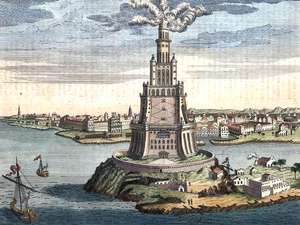
The lighthouse was constructed in the 3rd century BC. After Alexander the Great died, the first Ptolemy (Ptolemy I Soter) announced himself king in 305 BC, and commissioned its construction shortly thereafter. The building was finished during the reign of his son, the second Ptolemy (Ptolemy II Philadelphus). It took twelve years to complete, at a total cost of 800 talents, and served as a prototype for all later lighthouses in the world. The light was produced by a furnace at the top, and the tower was said to have been built mostly with solid blocks of limestone.
Strabo reported that Sostratus had a dedication inscribed in metal letters to the “Saviour Gods”. Later Pliny the Elder wrote that Sostratus was the architect, which is disputed. In the second century AD the satirist Lucian wrote that Sostratus inscribed his name under plaster bearing the name of Ptolemy. This was so that when the plaster with Ptolemy’s name fell off, Sostratus’s name would be visible in the stone.
5. Mausoleum at Halicarnassus
The Mausoleum at Halicarnassus or Tomb of Mausolus (Ancient Greek: Μαυσωλεῖον τῆς Ἁλικαρνασσοῦ; Turkish: Halikarnas Mozolesi) was a tomb built between 353 and 350 BC at Halicarnassus (present Bodrum, Turkey) for Mausolus, a satrap in the Persian Empire, and his sister-wife Artemisia II of Caria. The structure was designed by the Greek architects Satyros and Pythius of Priene. Its elevated tomb structure is derived from the tombs of neighbouring Lycia, such as the Nereid Monument.
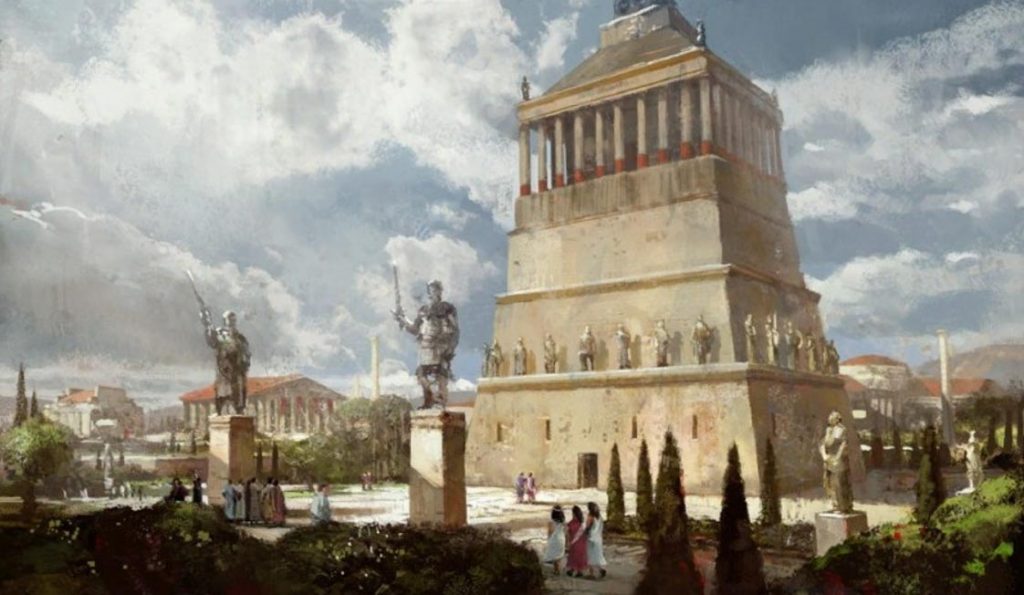
The Mausoleum was approximately 45 m (148 ft) in height, and the four sides were adorned with sculptural reliefs, each created by one of four Greek sculptors—Leochares, Bryaxis, Scopas of Paros and Timotheus. The finished structure of the mausoleum was considered to be such an aesthetic triumph that Antipater of Sidon identified it as one of his Seven Wonders of the Ancient World. It was destroyed by successive earthquakes from the 12th to the 15th century, the last surviving of the six destroyed wonders.
The word mausoleum has now come to be used generically for an above-ground tomb.
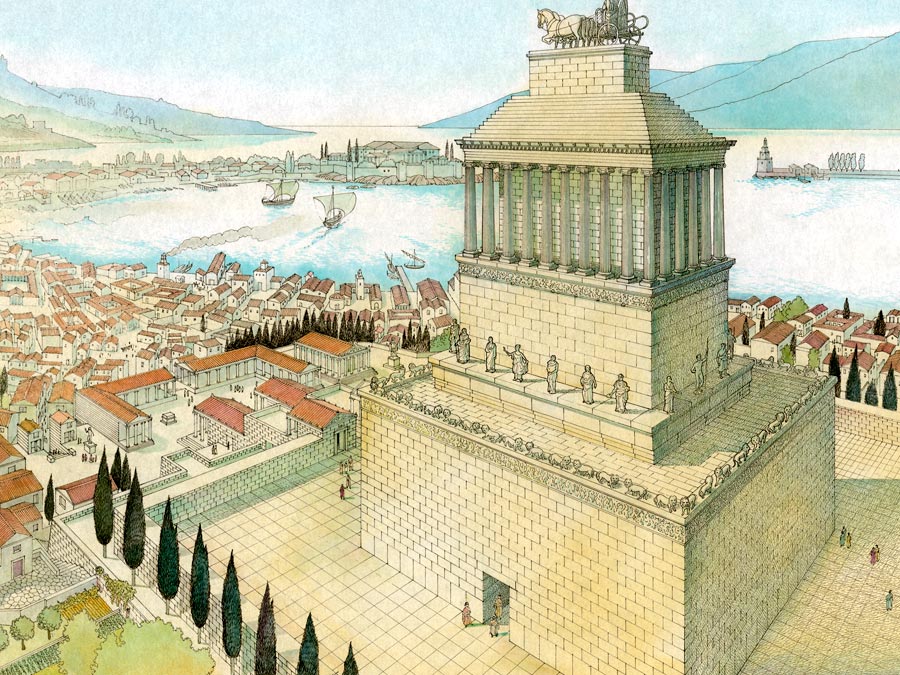
It is likely that Mausolos started to plan the tomb before his death, as part of the building works in Halicarnassus, and that when he died Artemisia continued the building project. Artemisia spared no expense in building the tomb. She sent messengers to Greece to find the most talented artists of the time. These included Scopas, the man who had supervised the rebuilding of the Temple of Artemis at Ephesus. The famous sculptors were (in the Vitruvius order): Leochares, Bryaxis, Scopas, and Timotheus, as well as hundreds of other craftsmen.
The tomb was erected on a hill overlooking the city. The whole structure sat in an enclosed courtyard. At the center of the courtyard was a stone platform on which the tomb sat. A stairway flanked by stone lions led to the top of the platform, which bore along its outer walls many statues of gods and goddesses. At each corner, stone warriors mounted on horseback guarded the tomb. At the center of the platform, the marble tomb rose as a square tapering block to one-third of the Mausoleum’s 45 m (148 ft) height. This section was covered with bas-reliefs showing action scenes, including the battle of the centaurs with the lapiths and Greeks in combat with the Amazons, a race of warrior women.
On the top of this section of the tomb thirty-six slim columns, ten per side, with each corner sharing one column between two sides; rose for another third of the height. Standing between each pair of columns was a statue. Behind the columns was a solid cella-like block that carried the weight of the tomb’s massive roof. The roof, which comprised most of the final third of the height, was pyramidal. Perched on the top was a quadriga: four massive horses pulling a chariot in which rode images of Mausolus and Artemisia.
6. Statue of Zeus at Olympia
The Statue of Zeus at Olympia was a giant seated figure, about 13 m (43 ft) tall, made by the Greek sculptor Phidias around 435 BC at the sanctuary of Olympia, Greece, and erected in the Temple of Zeus there. A sculpture of ivory plates and gold panels over a wooden framework, it represented the god Zeus sitting on an elaborate cedar wood throne ornamented with ebony, ivory, gold and precious stones. One of the Seven Wonders of the Ancient World, it was lost and destroyed during the 5th century AD with no copy ever being found, and details of its form are known only from ancient Greek descriptions and representations on coins.
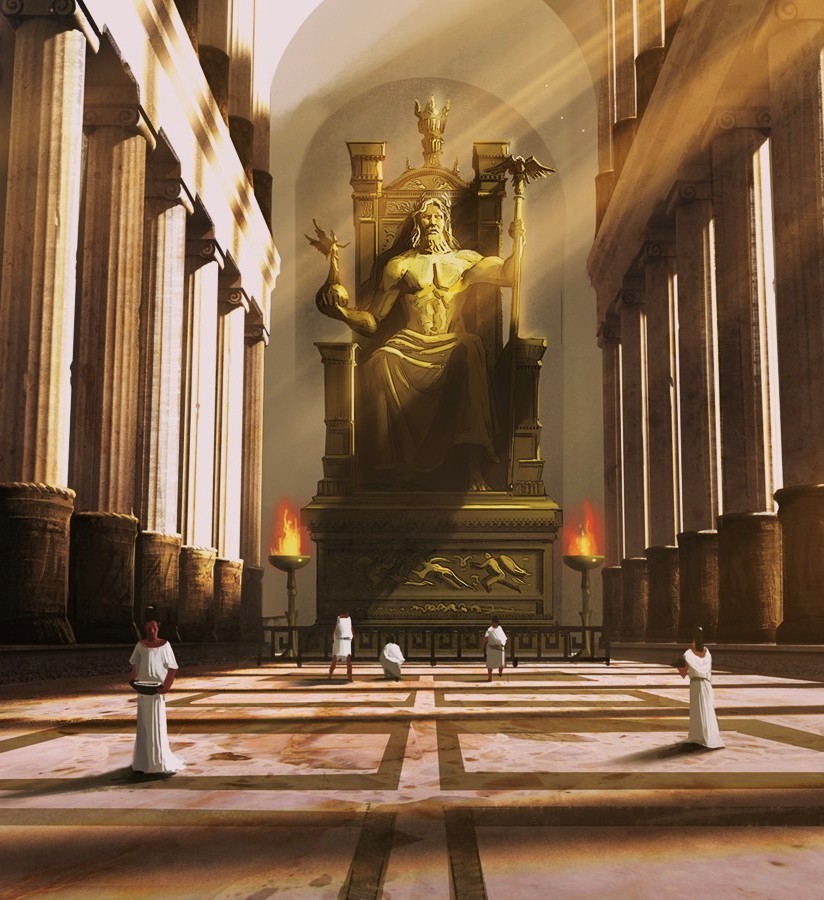
he statue of Zeus was commissioned by the Eleans, custodians of the Olympic Games, in the latter half of the fifth century BC for their recently constructed Temple of Zeus. Seeking to outdo their Athenian rivals, the Eleans employed the renowned sculptor Phidias, who had previously made the massive statue of Athena Parthenos in the Parthenon.
The great seated statue as fashioned by Phidias occupied half the width of the aisle of the temple built to house it. “It seems that if Zeus were to stand up,” the geographer Strabo noted early in the 1st century BC, “he would unroof the temple.” The Zeus was a chryselephantine sculpture, made with ivory and gold panels on a wooden substructure. No copy in marble or bronze has survived, though there are recognizable but only approximate versions on coins of nearby Elis and on Roman coins and engraved gems.
In the 2nd century AD, the geographer and traveler Pausanias gave a detailed description. The statue was crowned with a sculpted wreath of olive sprays, and wore a gilded robe made from glass and carved with animals and lilies. In its right hand was a small chryselephantine statue of crowned Nike, goddess of victory. Its left hand held a scepter inlaid with many metals, supporting an eagle. The throne featured painted figures and wrought images and was decorated in gold, precious stones, ebony, and ivory. Zeus’ golden sandals rested upon a footstool decorated with an Amazonomachy in relief. The passage underneath the throne was restricted by painted screens.
Pausanias also recounts that the statue was kept constantly coated with olive oil to counter the harmful effect on the ivory caused by the “marshiness” of the Altis grove. The floor in front of the image was paved with black tiles and surrounded by a raised rim of marble, to contain the oil. This reservoir acted as a reflecting pool which doubled the apparent height of the statue.
According to the Roman historian Livy, the Roman general Aemilius Paulus (the victor over Macedon) saw the statue and “was moved to his soul, as if he had seen the god in person,” while the 1st century AD Greek orator Dio Chrysostom declared that a single glimpse of the statue would make a man forget all his earthly troubles.
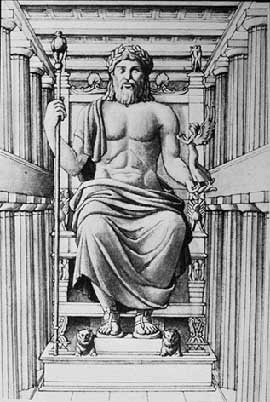
Roman Seated Zeus, marble and bronze (restored), following the type established by Phidias (Hermitage Museum, Saint Petersburg)
According to a legend, when Phidias was asked what inspired him—whether he climbed Mount Olympus to see Zeus, or whether Zeus came down from Olympus so that Phidias could see him—the artist answered that he portrayed Zeus according to Book One, verses 528 – 530 of Homer’s Iliad:
ἦ καὶ κυανέῃσιν ἐπ’ ὀφρύσι νεῦσε Κρονίων
ἀμβρόσιαι δ’ ἄρα χαῖται ἐπερρώσαντο ἄνακτος
κρατὸς ἀπ’ ἀθανάτοιο μέγαν δ’ ἐλέλιξεν Ὄλυμπον.
He spoke, the son of Cronos, and nodded his head with the dark brows,
and the immortally anointed hair of the great god
swept from his divine head, and all Olympos was shaken.[13]
The sculptor also was reputed to have immortalised Pantarkes, the winner of the boys’ wrestling event at the eighty-sixth Olympiad who was said to have been his “beloved” (eromenos), by carving Pantarkes kalos (“Pantarkes is beautiful”) into Zeus’s little finger, and by placing a relief of the boy crowning himself at the feet of the statue.
According to Pausanias, “when the image was quite finished Pheidias prayed the god to show by a sign whether the work was to his liking. Immediately, runs the legend, a thunderbolt fell on that part of the floor where down to the present day the bronze jar stood to cover the place.”
7. Temple of Artemis at Ephesus
The Temple of Artemis or Artemision (Greek: Ἀρτεμίσιον; Turkish: Artemis Tapınağı), also known less precisely as the Temple of Diana, was a Greek temple dedicated to an ancient, local form of the goddess Artemis. It was located in Ephesus (near the modern town of Selçuk in present-day Turkey). It was completely rebuilt three times, and in its final form was one of the Seven Wonders of the Ancient World. By 401 AD it had been ruined or destroyed. Only foundations and fragments of the last temple remain at the site.
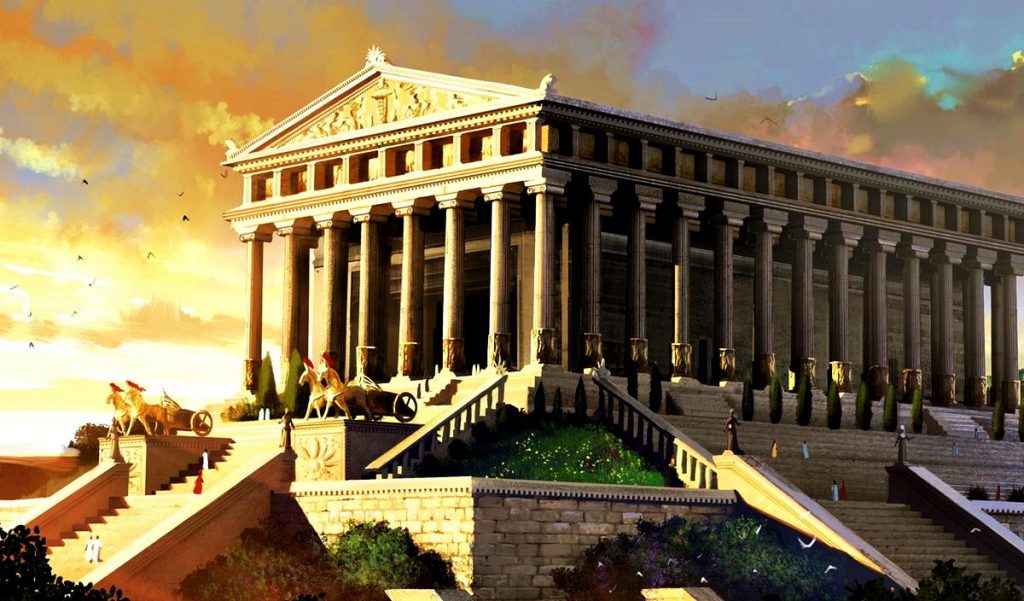
The earliest version of the temple (a temenos) antedated the Ionic immigration by many years, and dates to the Bronze Age. Callimachus, in his Hymn to Artemis, attributed it to the Amazons. In the 7th century BC, it was destroyed by a flood. Its reconstruction, in more grandiose form, began around 550 BC, under the Cretan architect Chersiphron and his son Metagenes. The project was funded by Croesus of Lydia, and took 10 years to complete. This version of the temple was destroyed in 356 BC by Herostratus in an act of arson. The next, greatest and last form of the temple, funded by the Ephesians themselves, is described in Antipater of Sidon’s list of the world’s Seven Wonders:
I have set eyes on the wall of lofty Babylon on which is a road for chariots, and the statue of Zeus by the Alpheus, and the hanging gardens, and the colossus of the Sun, and the huge labour of the high pyramids, and the vast tomb of Mausolus; but when I saw the house of Artemis that mounted to the clouds, those other marvels lost their brilliancy, and I said, “Lo, apart from Olympus, the Sun never looked on aught so grand”.








